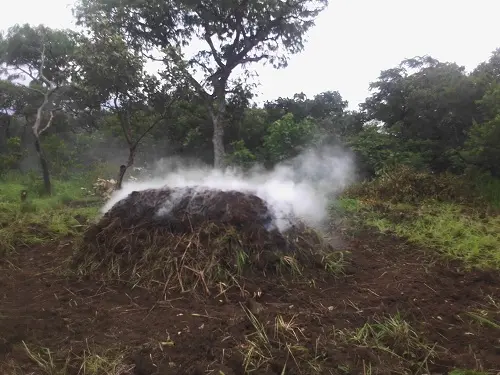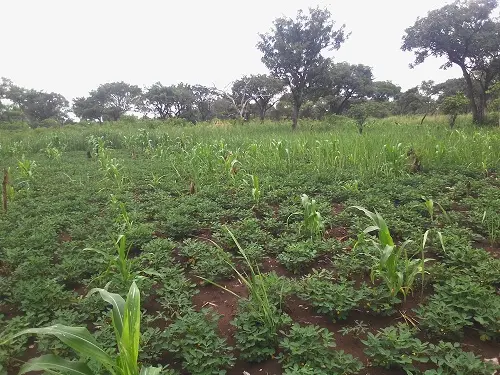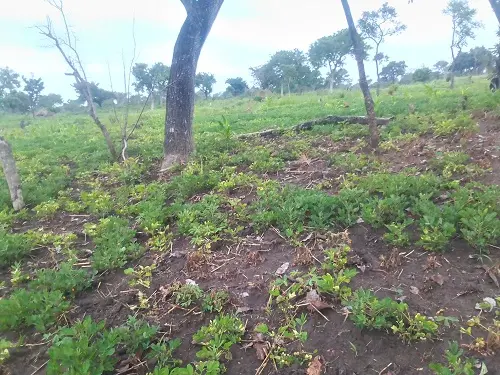Our website is available in English, Spanish, bahasa Indonesia, French, and Portuguese.

This story was produced with support from the Rainforest Journalism Fund in partnership with the Pulitzer Center.
A rough, dusty road from Yumbe town in West Nile sub-region of Uganda passes through Mount Kei national forest reserve (formally known as Mount Kei White Rhino Sanctuary). It leads to River Kaya, the Northern border of Uganda with South Sudan.
The Kaya River also marks the official northern end of the forest reserve.

As a nonprofit journalism organization, we depend on your support to fund journalism covering underreported issues around the world. Donate any amount today to become a Pulitzer Center Champion and receive exclusive benefits!
From the roadside, the forest looks like it’s sprawling with giant natural trees, shrubs and thickets.
However, just a few metres on a narrow path branching westwards into the forest, about three kilometers to Morta Bridge on Kaya River, the scale of destruction is unprecedented.
Farmlands, churches, mosques, trading centers and settlements, all illegal according to the National Forest Authority (NFA), have sliced off large swaths of forestland.
A hazy atmosphere hovers above the forest, caused by smoke wafting from burning heaps of earth-covered logs in charcoal kilns.
On a rain-drenched Tuesday, encroachers cleaned around anthills to prepare for the night’s catch of white ants, a cherished seasonal delicacy.
Others kept busy weeding under their cassava, maize, groundnuts, and other crops grown inside the forest.

Meanwhile, middlemen on motorcycles balanced their way through the paths with sacks of charcoal, some of them carrying as many as three or four sacks in a single trip.
Their destination? Busia border market in Koboko district where Ugandans, South Sudanese, and other nationalities trade in illegal forest products with impunity.
Such activities of illegal settlers, loggers, poachers and traders have contributed to loss of tree cover on 193 hectares of the 40,689 hectares Mt Kei forest reserve land and threatened its biodiversity, says Robert Owiny, NFA’s former range manager for West Nile.
Biodiversity richness
The Mt Kei Forest Reserve was initially created as a 170 square miles sanctuary in 1938, mainly to conserve the endangered white rhinoceros.
It was one of three such sanctuaries set up in West Nile along with Mount Otze and Ajai Game reserve.
But as indicated by the Rhino Resource Center, white rhinos in Mount Kei were finished by poachers by 1967.
Still the reserve is an important bio-diverse ecological area classified into dry combretum-Terminalia-Laudentia savanna and Brtyrospermum (Shea nut) savanna woodlands.
The Reserve has 175 bird species according to the Bird Life international. The Digital Observatory for Protected Areas (DOPA) explorer lists 456 bird species endemic to Mt Kei Forest Reserve of which two species—white headed vultures and hooded vultures were considered critically endangered by 2001; lappet-faced vultures, rupell’s vultures, white-backed vultures and steppe eagle were endangered birds while the African skimmer, black-tailed godwit, bearded vulture and the great snipe were near threatened.
There are about 17 amphibian species in various swamps and streams in the forest reserve and 144 mammal species according to DOPA, though some of them such as chimpanzees, De Brazza’s Monkey and Buffalos which are classified in the DOPA list as endangered, are actually extinct in Mount Kei Forest Reserve, locals say.
Other nocturnal animal species under constant threat are the African Savanna hare, hyrax, pangolins, hedge-hogs and antelopes of various types which are heavily hunted and eaten by the communal poachers living in and around the reserve.
A walk through the forest comes with the delight of one getting into contact with about 180 species of butterflies and moths buzzing the area as venomous snakes roam.
Mt Kei boasts of 32 rodent species and ten species of shrew, of which Crocidura Samalica is known from no other location in Uganda.
On the floral front, there are 30 uncommon plant species, three of them, shrubby aromatic herbs including aeschynomene, titanophylla and combretum (bush willow) are known in Uganda from this reserve only.
The Afzelia Africana (African oak) has been dangerously plundered by illegal loggers while the shea nut is under pressure from charcoal burners and farmers indiscriminately felling trees.
Threat level
According to the important bird areas, a global initiative of Bird Life International, agricultural expansion and intensification for annual and perennial non-timber crops by small holder farmers and livestock grazing constituted the biggest threat to Mt Kei Forest reserve.
This is coupled with logging, wood harvest for fuel and building material and dry season fires.
The DOPA Explorer’s data shows that Mt Kei’s forest cover in 2000 was 166.3 square kilometers or 40.1% of the reserve area while forest loss between 2000 and 2018 was 19.6 square kilometers with zero gains.
The Copernicus Global Land Cover 2019 gives more encouraging data, putting tree cover at 393.82 square kilometers or 94.88% of the reserve area.
It, however, shows that there were 7,934 people who have invaded the forest, the biggest concentration of which is marked red on the map.
The golden yellow area shows parts of the forest reserve already turned into farmland and, while the surrounding areas on the Ugandan side are heavily cultivated, the South Sudan side is mostly green with tree cover.
The tree cover along the South Sudan border has been a source of controversy over the years, with claims that cross-border criminals who harvest logs illegally from Mount Kei move them across the border before transporting them back to Uganda in order to confuse the origin.
Counter-accusations
Locals accuse NFA, Police and elements within the Ugandan security apparatus of orchestrating the destruction.
Some of their claims appear to be valid. For instance, police records show that on December 15, 2018, at Mount Kei, Emmanuel Biara, and Assistant Superintendent of Police, Julius Twesigye, who was the Officer in charge of Operation in Koboko district, were arrested with truck number UAQ889H/UAQ132C. They were using the vehicle to commandeer banned Afzelia Africana logs from Mt Kei Forest Reserve.
The duo was taken into custody at Kei Police post and case SD Ref 03/15/12/2018 registered against them. But Twesigye received a slap on the wrist from the authorities, he was transferred to Karamoja region in North Eastern Uganda and the case bungled up.
Under Section 14 (2) of the National Forestry and Tree Planting Act 2003, suspects of offenses related to cutting, disturbing, damaging, burning, or destroying any forest product are supposed to be prosecuted and upon conviction, fined not less than fifty currency points or imprisonment not exceeding five years or both.
A currency point is sh20,000 (USD$5.37), meaning not less than 50 currency points would be a fine from sh1m (USD$268.69) upwards.
Godfrey Onzima, the Member of Parliament for Aringa North Constituency where the largest part of Mt Kei forest reserve falls has weighed in, citing NFA hypocrisy for the destruction of the forest.
“Most of the lorries carrying logs and charcoal do not end in Uganda but sometimes move across to Kenya. When you confront the people destroying the forest, they mention names of big people in government, some of the forest destroyers are even guarded with state guns,” he said.
On the other hand, officers working with entities like the police and NFA shift the blame on encroachers and rebels across the border in South Sudan whom they allege are taking advantage of the unguarded border to destroy the forest.
At Kome trading center in Luro Village, Chakulia parish in Ludara Sub-County, Koboko district, residents were bush rebuilding their shops vandalized by NFA operatives in a March 2022 operation, ostensibly to chase out encroachers.
Andrew Zubair Sanya says this is a routine experience which started in 2004 and has been conducted by NFA between March and April each year with futile results.
“My house has been burned twice but we are not going anywhere because this is our ancestral land not a forest reserve,” the member of Yenga clan says.
“NFA is tormenting us. They destroy houses, burn crops by slashing and spraying chemicals on others. When we tell them this is not a forest reserve, they shoot at us; they take bribes of sh50,000 to spare a shop and after destroying things they loot animals, chicken and foodstuff,” he complained.
“This is not an operation to save Mout Kei forest, it is a looting expedition,” Sanya charged.

Officials claim that such operations have resulted in recovery of about 28 hectares of forest land from encroachers but the evidence on ground points to the contrary.
When a similar operation was carried out in 2014, shops at Kome trading center were grass thatched, mud and wattle walled, today many of them are brick walled and iron roofed.
Community members say after burning their houses and churches and retreating, they simply rebuilt them and continued their activities.
The socio-political uproar triggered by that botched operation in March resulted in the transfer of at least three senior NFA staff including Range Manager Owiny.
NFA’s Mandate
The NFA is the body constitutionally created and mandated to take care of Uganda’s Central Forest Reserves (CFRs) under Article 52 of the National Forestry and Tree Planting Act 2003.
Some of its functions are to develop and manage all CFRs, identify and recommend to the minister areas for declaration as CFRs or amendments to those declarations; promote innovative approaches for local community participation in management of CFRs and establish procedures for sustainable utilization of Uganda’s forest resources by and for the benefit of the people of Uganda.
Milton Nyeko, the new range manager for West Nile, says owing to the current situation, they convened a meeting that brought together disgruntled community members and local leaders including the council members of Yumbe and Koboko district as well as the Members of Parliament from those areas.
“We have agreed to halt any evictions until the boundaries of the forest reserve are demarcated,” he said.
They are also going to register everybody found within the forest reserve in order to establish the exact number of encroachers and embark on collaborative forest management as envisioned in Article 15 of the National Forestry and Tree Planting Act.
To combat trans-boundary forest crimes, the new officers including the Mount Kei forest reserve sector manager, Harunah Busobozi, have established a communication channel with Gen Taban Deng Gai, one of the Vice Presidents in the South Sudan Unity government.
“Gen Taban has given us the list of genuine dealers in forest products from South Sudan. They move with logs, charcoal and timber through Mt Kei Forest Reserve,” Busobozi said.
He gave no further details of the list, but confirmed that South Sudan informers tell them about every vehicle that passes through the forest reserve and that they clear the vehicles based on such information.
Gen Deng’s measures appear to consolidate a September 22, 2018 letter written by the Governor of Yei River State, calling on his counterparts in Uganda, particularly the Resident District Commissioners of Yumbe, Moyo and Koboko to collaborate in stumping out illegal logging.
The governor identified the sneaking routes of illegal loggers as Panume-Morobo-Kaya-Busia-Keri road, Kagoropa, another Koboko-South Sudan border crossing and Puse of Liwolo County to Mijale in Yumbe district.
Busobozi says what they are unable to control are rebels who control swaths of territory bordering Mt Kei Forest reserve on the South Sudan side and that no cross-border forest criminal has been prosecuted in relation to Mt Kei Forest reserve destruction.
Collaborative management
Speaking of collaborative forest management, Muzamil Acema of the Center for Economic Empowerment, Uganda, says they have been engaging in capacity building of encroachers and forest reserve neighbors in Yumbe district since 2016.
He disclosed that 98 groups each having 30 members have been registered and sensitized on restoration, tree planting, and environmental protection in the sub counties of Kei, Kerwa, Arilo and Midigo in Yumbe sector of the forest reserve.
However, ironically the NFA which in this partnership arrangement, was supposed to supply tree seedlings for the community members to plant has not played its part.
World Bank offers hope
The April 23, 2020 approval of USD$148.2b (sh552.6 trillion) financing facility by the board of executive directors of the World Bank to improve sustainable management of forests and protected areas in Uganda has given Mt Kei Forest reserve a ray of hope.
Under this initiative, Mt Kei is set to get USD$148m (sh551,77b) for infrastructure for management and protection including participatory management with communities for the period up to June 30, 2026.
Nyeko indicated that preparatory activities are already underway, and the community will be involved in the restoration efforts to recover degraded areas.
“We will organize the communities living around the forest to participate in forest management through a structured mechanism and support them with enterprises like bee keeping,” he said.









